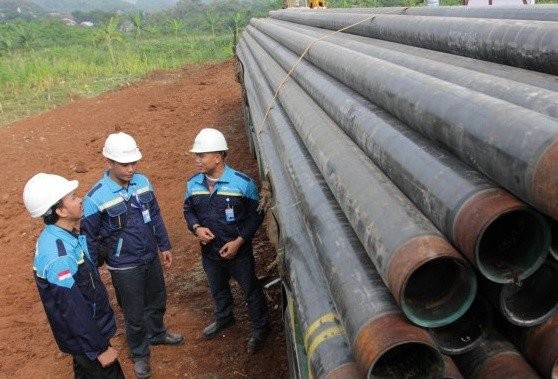Popular Reads
Top Results
Can't find what you're looking for?
View all search resultsPopular Reads
Top Results
Can't find what you're looking for?
View all search resultsIndustries to enjoy lower gas prices in 2017
Change text size
Gift Premium Articles
to Anyone
More industries will enjoy lower gas prices by the beginning of next year as the government rushes to find a solution to cost issues.
President Joko “Jokowi” Widodo has demanded that his Cabinet take concrete steps by the end of November to enable gas prices to fall below US$6 per million British thermal units (mmbtu) for 10 industrial sectors and one industrial zone starting in January next year.
Currently, only seven industries enjoy the lower gas prices, but the government plans to add pulp and paper, food and beverages, and textiles to the list.
Indonesia’s gas prices are around $9 per mmbtu, higher than most of its Southeast Asian neighbors. Both Malaysia and Singapore, for example, sell gas at around $4 per mmbtu.
“I calculated it the other day and found that a figure between $5 and $6 [per mmbtu] is possible. Simplify and cut down the supply chain, so that it will be more efficient,” Jokowi said before a closed-door meeting.
“This will affect the gas sector’s investment climate. Gas prices must remain enticing for investors to continue investing in our upstream sector, which will support the development of infrastructure, transmission and distribution.”
The government has been trying to lower gas prices for some time to boost income tax through improved industrial productivity.
High prices have forced many factories in North Sumatra to close down and as many as 20,000 workers have been laid off since 2000, data from the Association of Gas-Consuming Companies (Apigas) shows.
Industry Minister Airlangga Hartarto said the economic benefit of lower gas prices could reach Rp 31 trillion ($2.39 billion) if prices were cut to $4 per mmbtu, with an additional distribution cost of $1.50 to $2. He added that the 10 industrial sectors contributed around Rp 1,200 trillion, or 10 percent, of gross domestic product (GDP). The gas price cut is expected to increase their contribution to GDP as costs fall.
The Energy and Mineral Resources Ministry previously issued a regulation that allows companies to obtain an additional price cut of $2 per mmbtu from the minister if gas prices climb higher than $6 per mmbtu.
However, the regulation only applies to seven industries. Wider coverage for other industries is deemed essential as they expect to use more gas for production in the coming decade. The fertilizer and petrochemical industries use the most natural gas, as it is an essential component of their end products.
The fertilizer industry used 791.22 million standard cubic feet per day (mmscfd) of natural gas by the end of last year and is projected to need around 1,028.22 mmscfd in 2020.
Meanwhile, the petrochemical industry used 295 mmscfd in 2015 and is expected to increase its usage to 708 mmscfd in 2020.
State-owned fertilizer producer Pupuk Indonesia president director Aas Asikin Idat expressed hope that gas prices nationwide could be cut to $3 to $4 per mmbtu from the current price range of $6.50 to $8.50.
“Any price cuts will be extremely helpful because it is difficult to compete now with the current prices.”
Aas said that under the current pricing scheme, the production cost difference between Pupuk Indonesia and producers in the US and China could reach $50 per ton. Pupuk Indonesia’s production cost hovers at around $240 per ton at present.
Separately, state-owned oil and gas firm Pertamina’s executive director Dwi Soetjipto said lowering gas prices in Indonesia even further would be difficult because of geological and cost-related issues. “Indonesia’s gas reserves can be found in small pockets that are found scattered around the country, unlike other countries in the Middle East that have large reserves in one location. This means the transportation per volume cost is higher,” he said.
“Moreover, the use of high-tech equipment will need more capital expenditure as well.”
________________________________
To receive comprehensive and earlier access to The Jakarta Post print edition, please subscribe to our epaper through iOS' iTunes, Android's Google Play, Blackberry World or Microsoft's Windows Store. Subscription includes free daily editions of The Nation, The Star Malaysia, the Philippine Daily Inquirer and Asia News.
For print subscription, please contact our call center at (+6221) 5360014 or subscription@thejakartapost.com










